Financial Accounting & Reporting: Income Tax Analysis Report
VerifiedAdded on 2020/06/05
|10
|2719
|39
Report
AI Summary
This report examines income tax accounting practices, focusing on the requirements of AASB 112/IAS 12 regarding the recognition of deferred tax assets and liabilities. It analyzes the objectives of income tax accounting in general-purpose financial statements and compares the information related to income tax expenses, including components such as current and deferred tax. The report uses two companies, Ardea Resource Ltd and Adairs Ltd, to illustrate the application of these principles, comparing their financial reporting of income tax. It explores the impact of income tax disclosures on stakeholder decision-making, highlighting the importance of transparent and comprehensive reporting. The report concludes with a summary of the key findings and implications of income tax accounting practices.
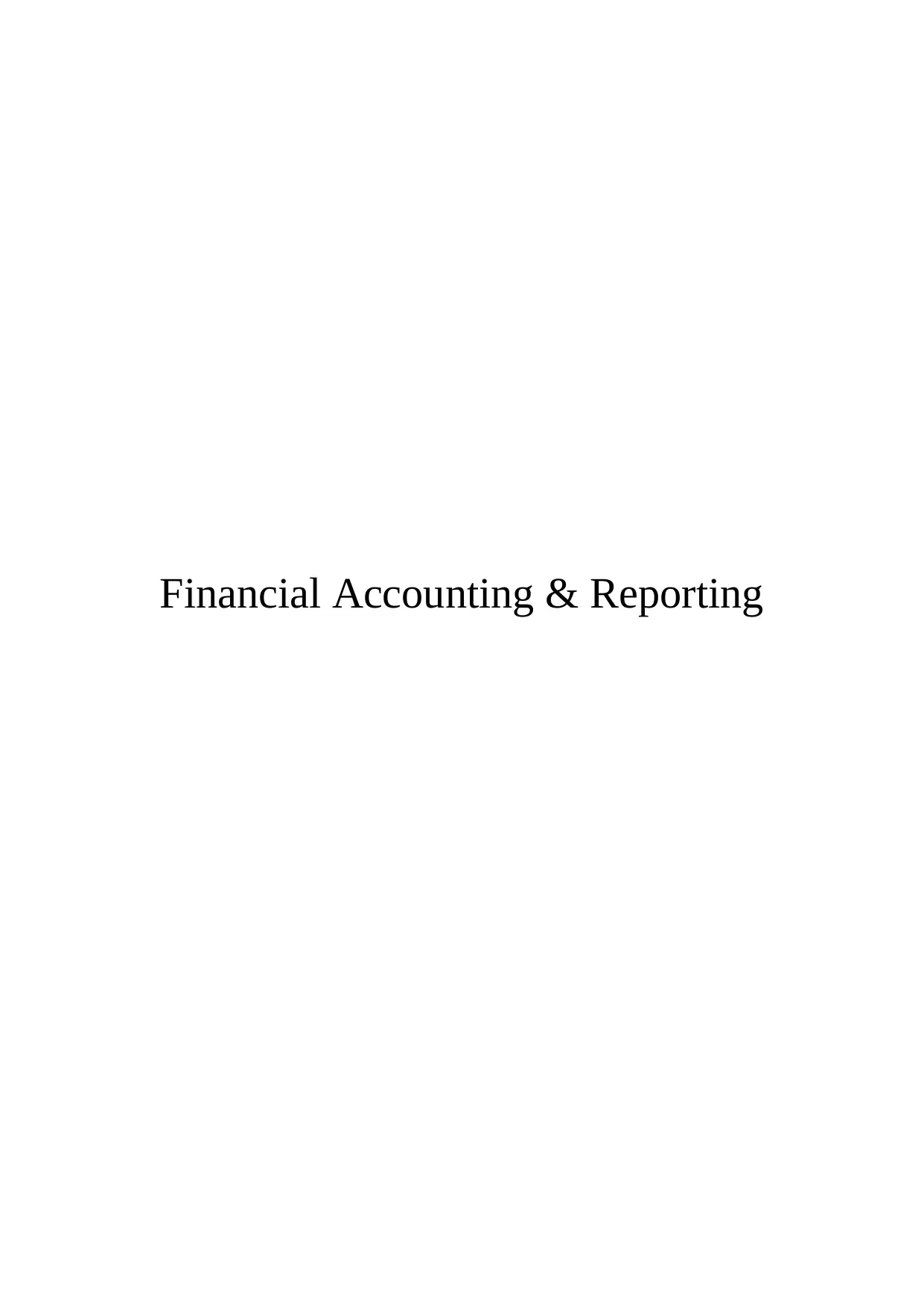
Financial Accounting & Reporting
Paraphrase This Document
Need a fresh take? Get an instant paraphrase of this document with our AI Paraphraser
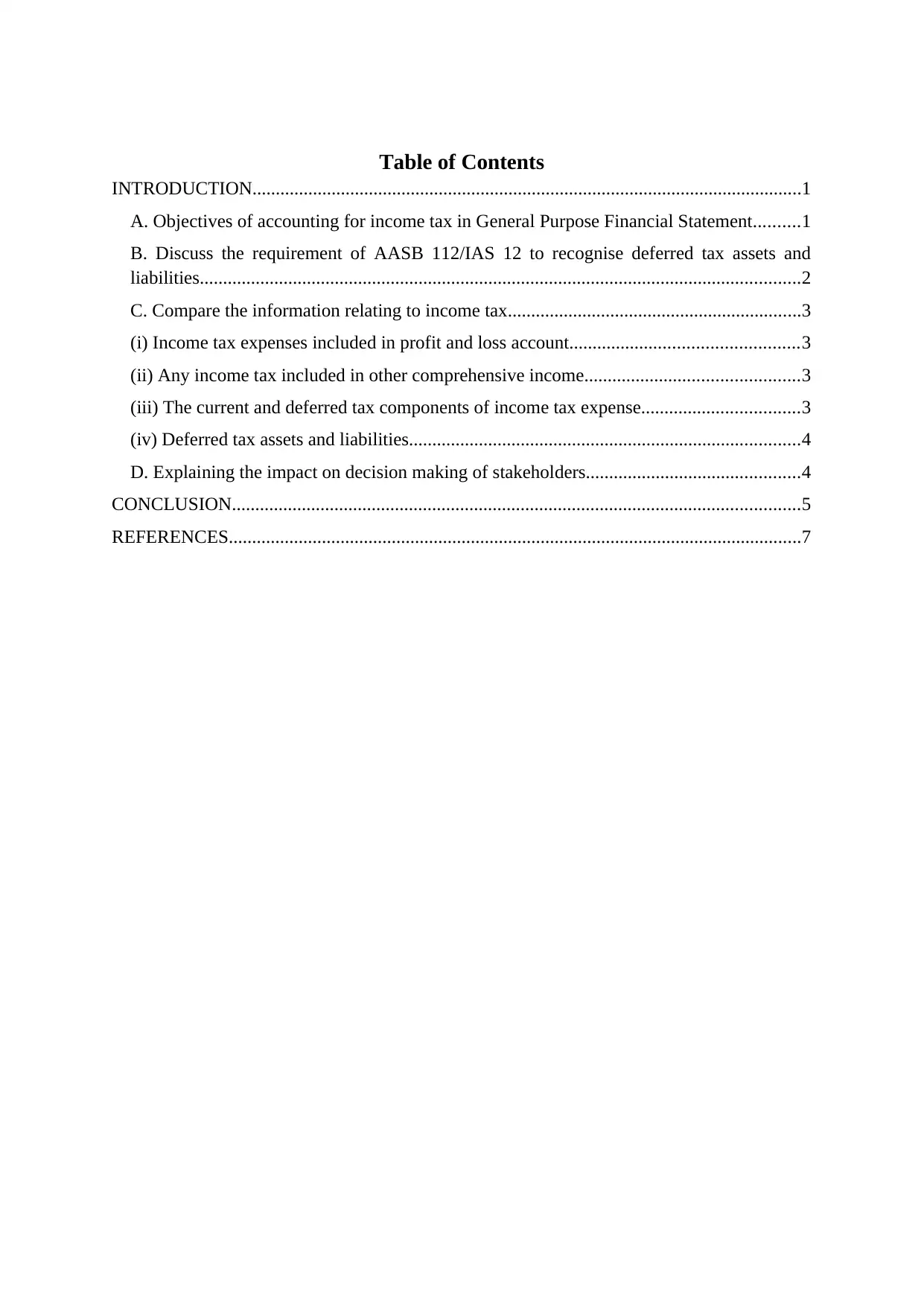
Table of Contents
INTRODUCTION......................................................................................................................1
A. Objectives of accounting for income tax in General Purpose Financial Statement..........1
B. Discuss the requirement of AASB 112/IAS 12 to recognise deferred tax assets and
liabilities.................................................................................................................................2
C. Compare the information relating to income tax...............................................................3
(i) Income tax expenses included in profit and loss account.................................................3
(ii) Any income tax included in other comprehensive income..............................................3
(iii) The current and deferred tax components of income tax expense..................................3
(iv) Deferred tax assets and liabilities....................................................................................4
D. Explaining the impact on decision making of stakeholders..............................................4
CONCLUSION..........................................................................................................................5
REFERENCES...........................................................................................................................7
INTRODUCTION......................................................................................................................1
A. Objectives of accounting for income tax in General Purpose Financial Statement..........1
B. Discuss the requirement of AASB 112/IAS 12 to recognise deferred tax assets and
liabilities.................................................................................................................................2
C. Compare the information relating to income tax...............................................................3
(i) Income tax expenses included in profit and loss account.................................................3
(ii) Any income tax included in other comprehensive income..............................................3
(iii) The current and deferred tax components of income tax expense..................................3
(iv) Deferred tax assets and liabilities....................................................................................4
D. Explaining the impact on decision making of stakeholders..............................................4
CONCLUSION..........................................................................................................................5
REFERENCES...........................................................................................................................7
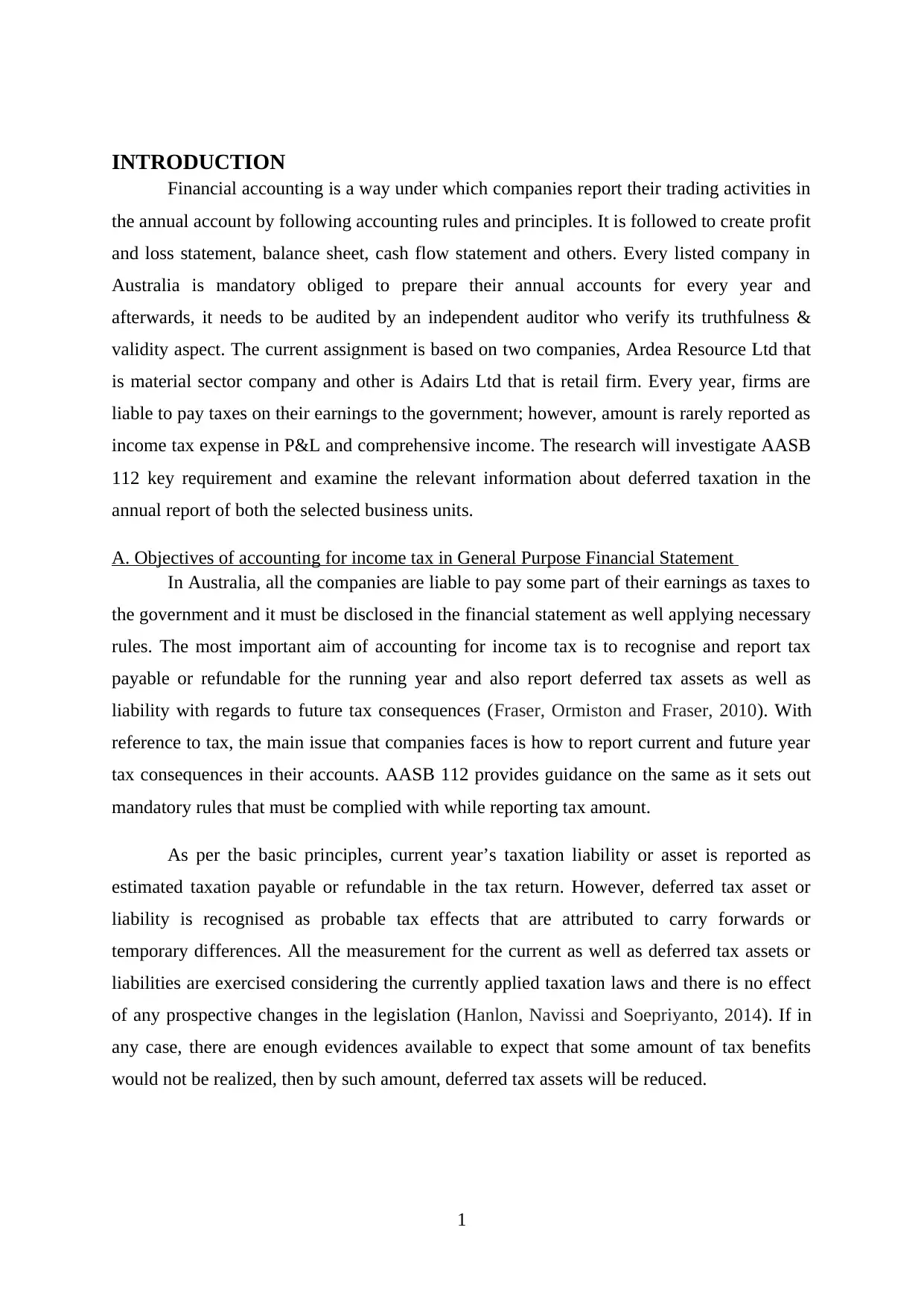
INTRODUCTION
Financial accounting is a way under which companies report their trading activities in
the annual account by following accounting rules and principles. It is followed to create profit
and loss statement, balance sheet, cash flow statement and others. Every listed company in
Australia is mandatory obliged to prepare their annual accounts for every year and
afterwards, it needs to be audited by an independent auditor who verify its truthfulness &
validity aspect. The current assignment is based on two companies, Ardea Resource Ltd that
is material sector company and other is Adairs Ltd that is retail firm. Every year, firms are
liable to pay taxes on their earnings to the government; however, amount is rarely reported as
income tax expense in P&L and comprehensive income. The research will investigate AASB
112 key requirement and examine the relevant information about deferred taxation in the
annual report of both the selected business units.
A. Objectives of accounting for income tax in General Purpose Financial Statement
In Australia, all the companies are liable to pay some part of their earnings as taxes to
the government and it must be disclosed in the financial statement as well applying necessary
rules. The most important aim of accounting for income tax is to recognise and report tax
payable or refundable for the running year and also report deferred tax assets as well as
liability with regards to future tax consequences (Fraser, Ormiston and Fraser, 2010). With
reference to tax, the main issue that companies faces is how to report current and future year
tax consequences in their accounts. AASB 112 provides guidance on the same as it sets out
mandatory rules that must be complied with while reporting tax amount.
As per the basic principles, current year’s taxation liability or asset is reported as
estimated taxation payable or refundable in the tax return. However, deferred tax asset or
liability is recognised as probable tax effects that are attributed to carry forwards or
temporary differences. All the measurement for the current as well as deferred tax assets or
liabilities are exercised considering the currently applied taxation laws and there is no effect
of any prospective changes in the legislation (Hanlon, Navissi and Soepriyanto, 2014). If in
any case, there are enough evidences available to expect that some amount of tax benefits
would not be realized, then by such amount, deferred tax assets will be reduced.
1
Financial accounting is a way under which companies report their trading activities in
the annual account by following accounting rules and principles. It is followed to create profit
and loss statement, balance sheet, cash flow statement and others. Every listed company in
Australia is mandatory obliged to prepare their annual accounts for every year and
afterwards, it needs to be audited by an independent auditor who verify its truthfulness &
validity aspect. The current assignment is based on two companies, Ardea Resource Ltd that
is material sector company and other is Adairs Ltd that is retail firm. Every year, firms are
liable to pay taxes on their earnings to the government; however, amount is rarely reported as
income tax expense in P&L and comprehensive income. The research will investigate AASB
112 key requirement and examine the relevant information about deferred taxation in the
annual report of both the selected business units.
A. Objectives of accounting for income tax in General Purpose Financial Statement
In Australia, all the companies are liable to pay some part of their earnings as taxes to
the government and it must be disclosed in the financial statement as well applying necessary
rules. The most important aim of accounting for income tax is to recognise and report tax
payable or refundable for the running year and also report deferred tax assets as well as
liability with regards to future tax consequences (Fraser, Ormiston and Fraser, 2010). With
reference to tax, the main issue that companies faces is how to report current and future year
tax consequences in their accounts. AASB 112 provides guidance on the same as it sets out
mandatory rules that must be complied with while reporting tax amount.
As per the basic principles, current year’s taxation liability or asset is reported as
estimated taxation payable or refundable in the tax return. However, deferred tax asset or
liability is recognised as probable tax effects that are attributed to carry forwards or
temporary differences. All the measurement for the current as well as deferred tax assets or
liabilities are exercised considering the currently applied taxation laws and there is no effect
of any prospective changes in the legislation (Hanlon, Navissi and Soepriyanto, 2014). If in
any case, there are enough evidences available to expect that some amount of tax benefits
would not be realized, then by such amount, deferred tax assets will be reduced.
1
⊘ This is a preview!⊘
Do you want full access?
Subscribe today to unlock all pages.

Trusted by 1+ million students worldwide
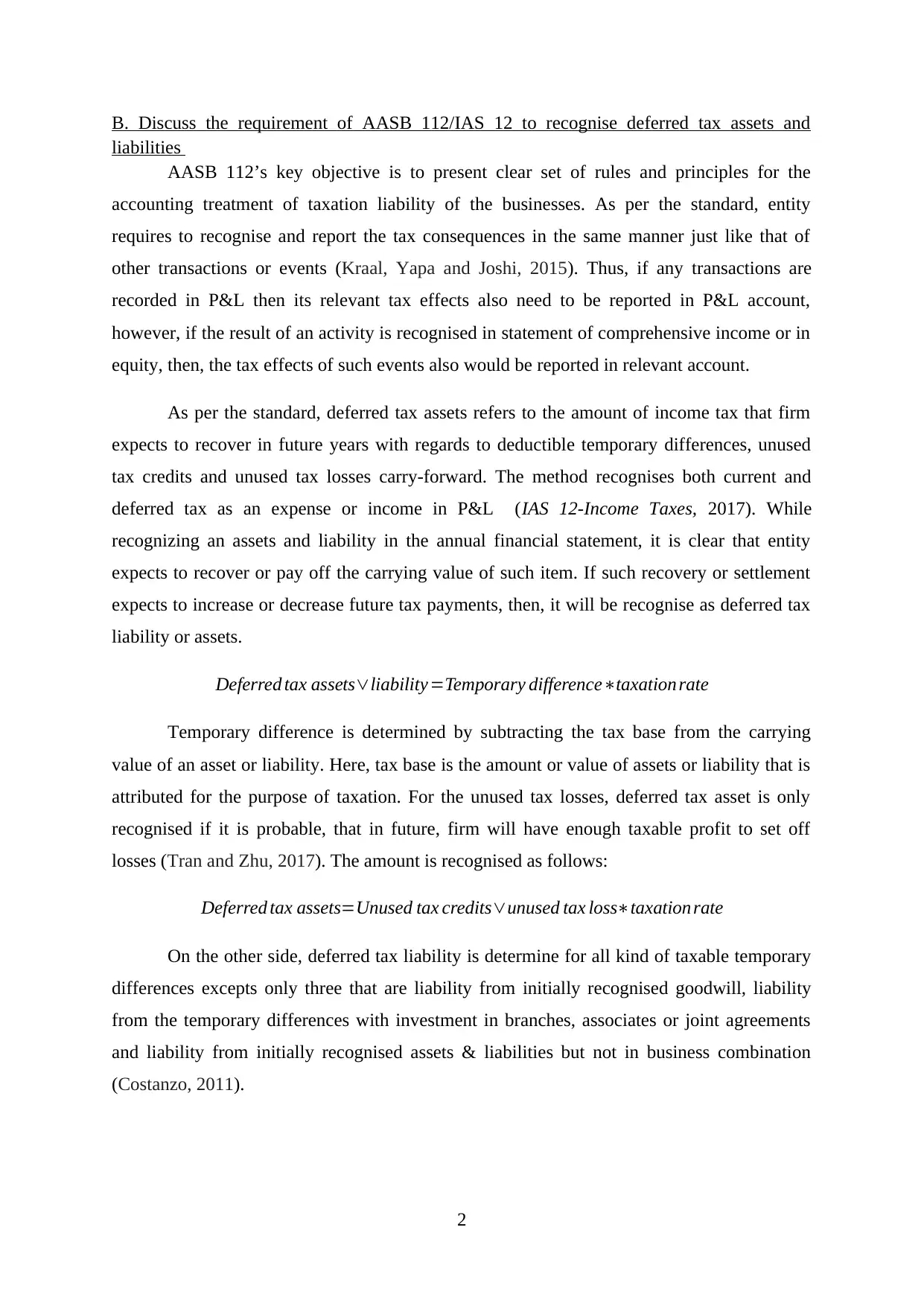
B. Discuss the requirement of AASB 112/IAS 12 to recognise deferred tax assets and
liabilities
AASB 112’s key objective is to present clear set of rules and principles for the
accounting treatment of taxation liability of the businesses. As per the standard, entity
requires to recognise and report the tax consequences in the same manner just like that of
other transactions or events (Kraal, Yapa and Joshi, 2015). Thus, if any transactions are
recorded in P&L then its relevant tax effects also need to be reported in P&L account,
however, if the result of an activity is recognised in statement of comprehensive income or in
equity, then, the tax effects of such events also would be reported in relevant account.
As per the standard, deferred tax assets refers to the amount of income tax that firm
expects to recover in future years with regards to deductible temporary differences, unused
tax credits and unused tax losses carry-forward. The method recognises both current and
deferred tax as an expense or income in P&L (IAS 12-Income Taxes, 2017). While
recognizing an assets and liability in the annual financial statement, it is clear that entity
expects to recover or pay off the carrying value of such item. If such recovery or settlement
expects to increase or decrease future tax payments, then, it will be recognise as deferred tax
liability or assets.
Deferred tax assets∨liability=Temporary difference∗taxation rate
Temporary difference is determined by subtracting the tax base from the carrying
value of an asset or liability. Here, tax base is the amount or value of assets or liability that is
attributed for the purpose of taxation. For the unused tax losses, deferred tax asset is only
recognised if it is probable, that in future, firm will have enough taxable profit to set off
losses (Tran and Zhu, 2017). The amount is recognised as follows:
Deferred tax assets=Unused tax credits∨unused tax loss∗taxation rate
On the other side, deferred tax liability is determine for all kind of taxable temporary
differences excepts only three that are liability from initially recognised goodwill, liability
from the temporary differences with investment in branches, associates or joint agreements
and liability from initially recognised assets & liabilities but not in business combination
(Costanzo, 2011).
2
liabilities
AASB 112’s key objective is to present clear set of rules and principles for the
accounting treatment of taxation liability of the businesses. As per the standard, entity
requires to recognise and report the tax consequences in the same manner just like that of
other transactions or events (Kraal, Yapa and Joshi, 2015). Thus, if any transactions are
recorded in P&L then its relevant tax effects also need to be reported in P&L account,
however, if the result of an activity is recognised in statement of comprehensive income or in
equity, then, the tax effects of such events also would be reported in relevant account.
As per the standard, deferred tax assets refers to the amount of income tax that firm
expects to recover in future years with regards to deductible temporary differences, unused
tax credits and unused tax losses carry-forward. The method recognises both current and
deferred tax as an expense or income in P&L (IAS 12-Income Taxes, 2017). While
recognizing an assets and liability in the annual financial statement, it is clear that entity
expects to recover or pay off the carrying value of such item. If such recovery or settlement
expects to increase or decrease future tax payments, then, it will be recognise as deferred tax
liability or assets.
Deferred tax assets∨liability=Temporary difference∗taxation rate
Temporary difference is determined by subtracting the tax base from the carrying
value of an asset or liability. Here, tax base is the amount or value of assets or liability that is
attributed for the purpose of taxation. For the unused tax losses, deferred tax asset is only
recognised if it is probable, that in future, firm will have enough taxable profit to set off
losses (Tran and Zhu, 2017). The amount is recognised as follows:
Deferred tax assets=Unused tax credits∨unused tax loss∗taxation rate
On the other side, deferred tax liability is determine for all kind of taxable temporary
differences excepts only three that are liability from initially recognised goodwill, liability
from the temporary differences with investment in branches, associates or joint agreements
and liability from initially recognised assets & liabilities but not in business combination
(Costanzo, 2011).
2
Paraphrase This Document
Need a fresh take? Get an instant paraphrase of this document with our AI Paraphraser
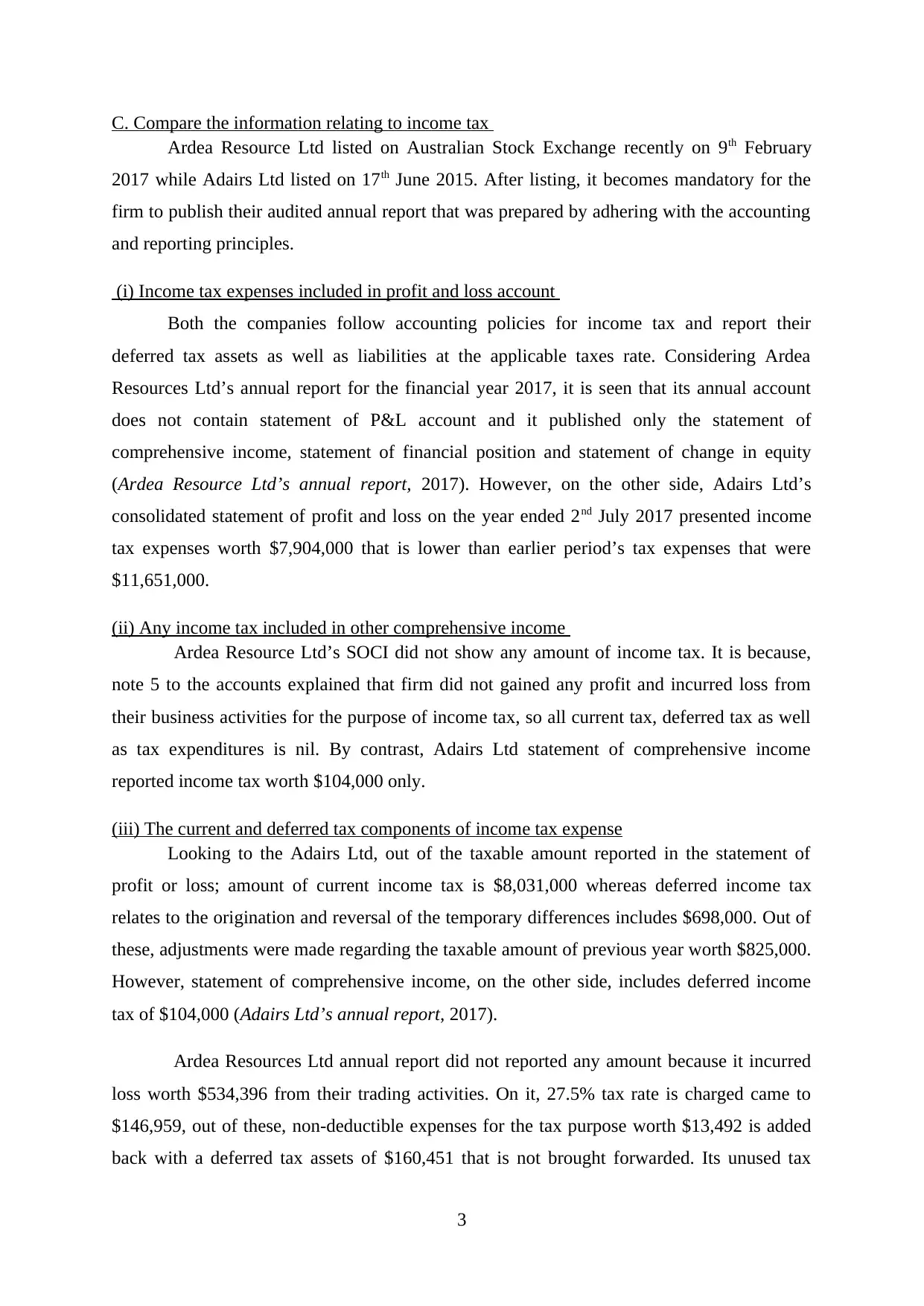
C. Compare the information relating to income tax
Ardea Resource Ltd listed on Australian Stock Exchange recently on 9th February
2017 while Adairs Ltd listed on 17th June 2015. After listing, it becomes mandatory for the
firm to publish their audited annual report that was prepared by adhering with the accounting
and reporting principles.
(i) Income tax expenses included in profit and loss account
Both the companies follow accounting policies for income tax and report their
deferred tax assets as well as liabilities at the applicable taxes rate. Considering Ardea
Resources Ltd’s annual report for the financial year 2017, it is seen that its annual account
does not contain statement of P&L account and it published only the statement of
comprehensive income, statement of financial position and statement of change in equity
(Ardea Resource Ltd’s annual report, 2017). However, on the other side, Adairs Ltd’s
consolidated statement of profit and loss on the year ended 2nd July 2017 presented income
tax expenses worth $7,904,000 that is lower than earlier period’s tax expenses that were
$11,651,000.
(ii) Any income tax included in other comprehensive income
Ardea Resource Ltd’s SOCI did not show any amount of income tax. It is because,
note 5 to the accounts explained that firm did not gained any profit and incurred loss from
their business activities for the purpose of income tax, so all current tax, deferred tax as well
as tax expenditures is nil. By contrast, Adairs Ltd statement of comprehensive income
reported income tax worth $104,000 only.
(iii) The current and deferred tax components of income tax expense
Looking to the Adairs Ltd, out of the taxable amount reported in the statement of
profit or loss; amount of current income tax is $8,031,000 whereas deferred income tax
relates to the origination and reversal of the temporary differences includes $698,000. Out of
these, adjustments were made regarding the taxable amount of previous year worth $825,000.
However, statement of comprehensive income, on the other side, includes deferred income
tax of $104,000 (Adairs Ltd’s annual report, 2017).
Ardea Resources Ltd annual report did not reported any amount because it incurred
loss worth $534,396 from their trading activities. On it, 27.5% tax rate is charged came to
$146,959, out of these, non-deductible expenses for the tax purpose worth $13,492 is added
back with a deferred tax assets of $160,451 that is not brought forwarded. Its unused tax
3
Ardea Resource Ltd listed on Australian Stock Exchange recently on 9th February
2017 while Adairs Ltd listed on 17th June 2015. After listing, it becomes mandatory for the
firm to publish their audited annual report that was prepared by adhering with the accounting
and reporting principles.
(i) Income tax expenses included in profit and loss account
Both the companies follow accounting policies for income tax and report their
deferred tax assets as well as liabilities at the applicable taxes rate. Considering Ardea
Resources Ltd’s annual report for the financial year 2017, it is seen that its annual account
does not contain statement of P&L account and it published only the statement of
comprehensive income, statement of financial position and statement of change in equity
(Ardea Resource Ltd’s annual report, 2017). However, on the other side, Adairs Ltd’s
consolidated statement of profit and loss on the year ended 2nd July 2017 presented income
tax expenses worth $7,904,000 that is lower than earlier period’s tax expenses that were
$11,651,000.
(ii) Any income tax included in other comprehensive income
Ardea Resource Ltd’s SOCI did not show any amount of income tax. It is because,
note 5 to the accounts explained that firm did not gained any profit and incurred loss from
their business activities for the purpose of income tax, so all current tax, deferred tax as well
as tax expenditures is nil. By contrast, Adairs Ltd statement of comprehensive income
reported income tax worth $104,000 only.
(iii) The current and deferred tax components of income tax expense
Looking to the Adairs Ltd, out of the taxable amount reported in the statement of
profit or loss; amount of current income tax is $8,031,000 whereas deferred income tax
relates to the origination and reversal of the temporary differences includes $698,000. Out of
these, adjustments were made regarding the taxable amount of previous year worth $825,000.
However, statement of comprehensive income, on the other side, includes deferred income
tax of $104,000 (Adairs Ltd’s annual report, 2017).
Ardea Resources Ltd annual report did not reported any amount because it incurred
loss worth $534,396 from their trading activities. On it, 27.5% tax rate is charged came to
$146,959, out of these, non-deductible expenses for the tax purpose worth $13,492 is added
back with a deferred tax assets of $160,451 that is not brought forwarded. Its unused tax
3
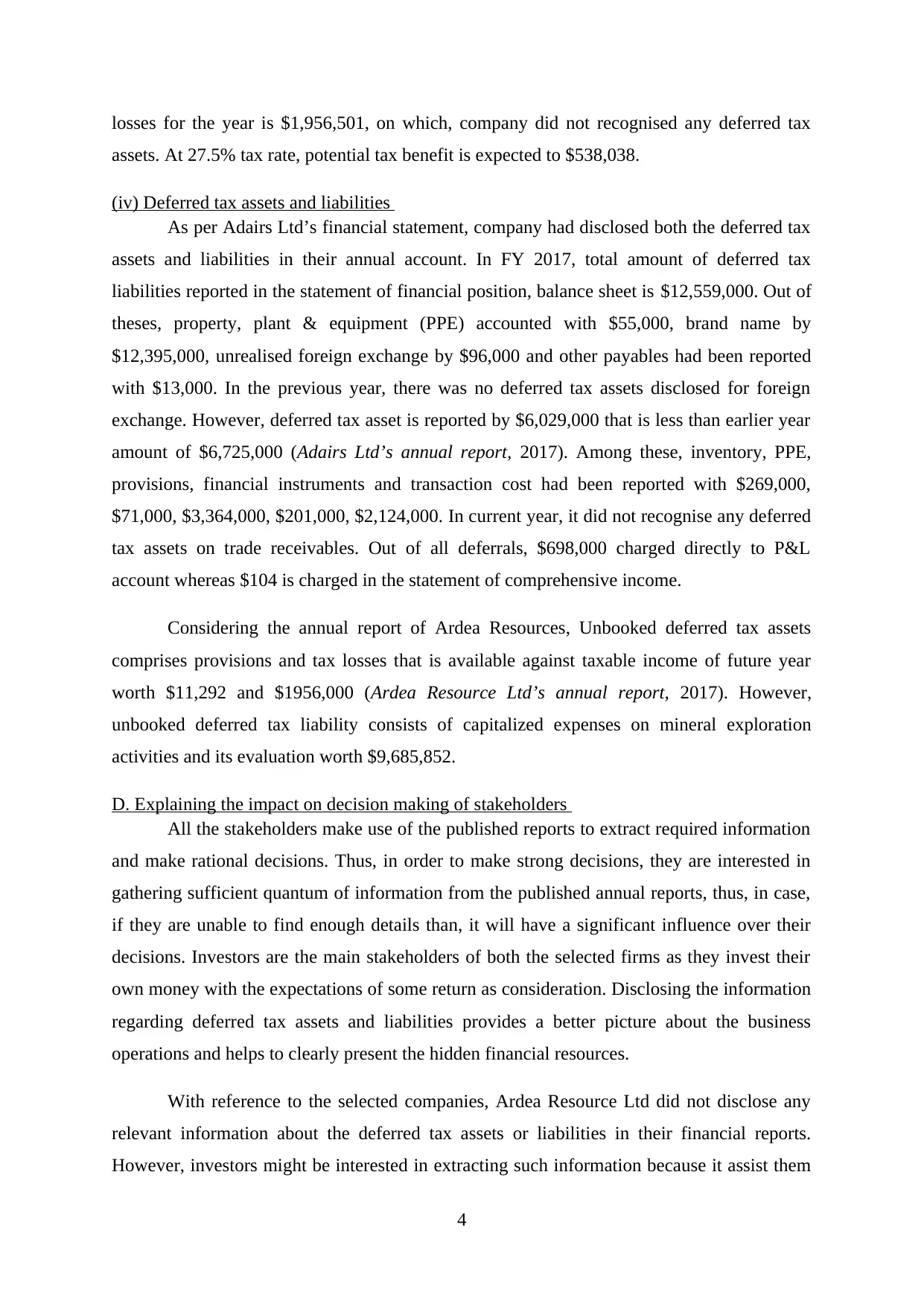
losses for the year is $1,956,501, on which, company did not recognised any deferred tax
assets. At 27.5% tax rate, potential tax benefit is expected to $538,038.
(iv) Deferred tax assets and liabilities
As per Adairs Ltd’s financial statement, company had disclosed both the deferred tax
assets and liabilities in their annual account. In FY 2017, total amount of deferred tax
liabilities reported in the statement of financial position, balance sheet is $12,559,000. Out of
theses, property, plant & equipment (PPE) accounted with $55,000, brand name by
$12,395,000, unrealised foreign exchange by $96,000 and other payables had been reported
with $13,000. In the previous year, there was no deferred tax assets disclosed for foreign
exchange. However, deferred tax asset is reported by $6,029,000 that is less than earlier year
amount of $6,725,000 (Adairs Ltd’s annual report, 2017). Among these, inventory, PPE,
provisions, financial instruments and transaction cost had been reported with $269,000,
$71,000, $3,364,000, $201,000, $2,124,000. In current year, it did not recognise any deferred
tax assets on trade receivables. Out of all deferrals, $698,000 charged directly to P&L
account whereas $104 is charged in the statement of comprehensive income.
Considering the annual report of Ardea Resources, Unbooked deferred tax assets
comprises provisions and tax losses that is available against taxable income of future year
worth $11,292 and $1956,000 (Ardea Resource Ltd’s annual report, 2017). However,
unbooked deferred tax liability consists of capitalized expenses on mineral exploration
activities and its evaluation worth $9,685,852.
D. Explaining the impact on decision making of stakeholders
All the stakeholders make use of the published reports to extract required information
and make rational decisions. Thus, in order to make strong decisions, they are interested in
gathering sufficient quantum of information from the published annual reports, thus, in case,
if they are unable to find enough details than, it will have a significant influence over their
decisions. Investors are the main stakeholders of both the selected firms as they invest their
own money with the expectations of some return as consideration. Disclosing the information
regarding deferred tax assets and liabilities provides a better picture about the business
operations and helps to clearly present the hidden financial resources.
With reference to the selected companies, Ardea Resource Ltd did not disclose any
relevant information about the deferred tax assets or liabilities in their financial reports.
However, investors might be interested in extracting such information because it assist them
4
assets. At 27.5% tax rate, potential tax benefit is expected to $538,038.
(iv) Deferred tax assets and liabilities
As per Adairs Ltd’s financial statement, company had disclosed both the deferred tax
assets and liabilities in their annual account. In FY 2017, total amount of deferred tax
liabilities reported in the statement of financial position, balance sheet is $12,559,000. Out of
theses, property, plant & equipment (PPE) accounted with $55,000, brand name by
$12,395,000, unrealised foreign exchange by $96,000 and other payables had been reported
with $13,000. In the previous year, there was no deferred tax assets disclosed for foreign
exchange. However, deferred tax asset is reported by $6,029,000 that is less than earlier year
amount of $6,725,000 (Adairs Ltd’s annual report, 2017). Among these, inventory, PPE,
provisions, financial instruments and transaction cost had been reported with $269,000,
$71,000, $3,364,000, $201,000, $2,124,000. In current year, it did not recognise any deferred
tax assets on trade receivables. Out of all deferrals, $698,000 charged directly to P&L
account whereas $104 is charged in the statement of comprehensive income.
Considering the annual report of Ardea Resources, Unbooked deferred tax assets
comprises provisions and tax losses that is available against taxable income of future year
worth $11,292 and $1956,000 (Ardea Resource Ltd’s annual report, 2017). However,
unbooked deferred tax liability consists of capitalized expenses on mineral exploration
activities and its evaluation worth $9,685,852.
D. Explaining the impact on decision making of stakeholders
All the stakeholders make use of the published reports to extract required information
and make rational decisions. Thus, in order to make strong decisions, they are interested in
gathering sufficient quantum of information from the published annual reports, thus, in case,
if they are unable to find enough details than, it will have a significant influence over their
decisions. Investors are the main stakeholders of both the selected firms as they invest their
own money with the expectations of some return as consideration. Disclosing the information
regarding deferred tax assets and liabilities provides a better picture about the business
operations and helps to clearly present the hidden financial resources.
With reference to the selected companies, Ardea Resource Ltd did not disclose any
relevant information about the deferred tax assets or liabilities in their financial reports.
However, investors might be interested in extracting such information because it assist them
4
⊘ This is a preview!⊘
Do you want full access?
Subscribe today to unlock all pages.

Trusted by 1+ million students worldwide
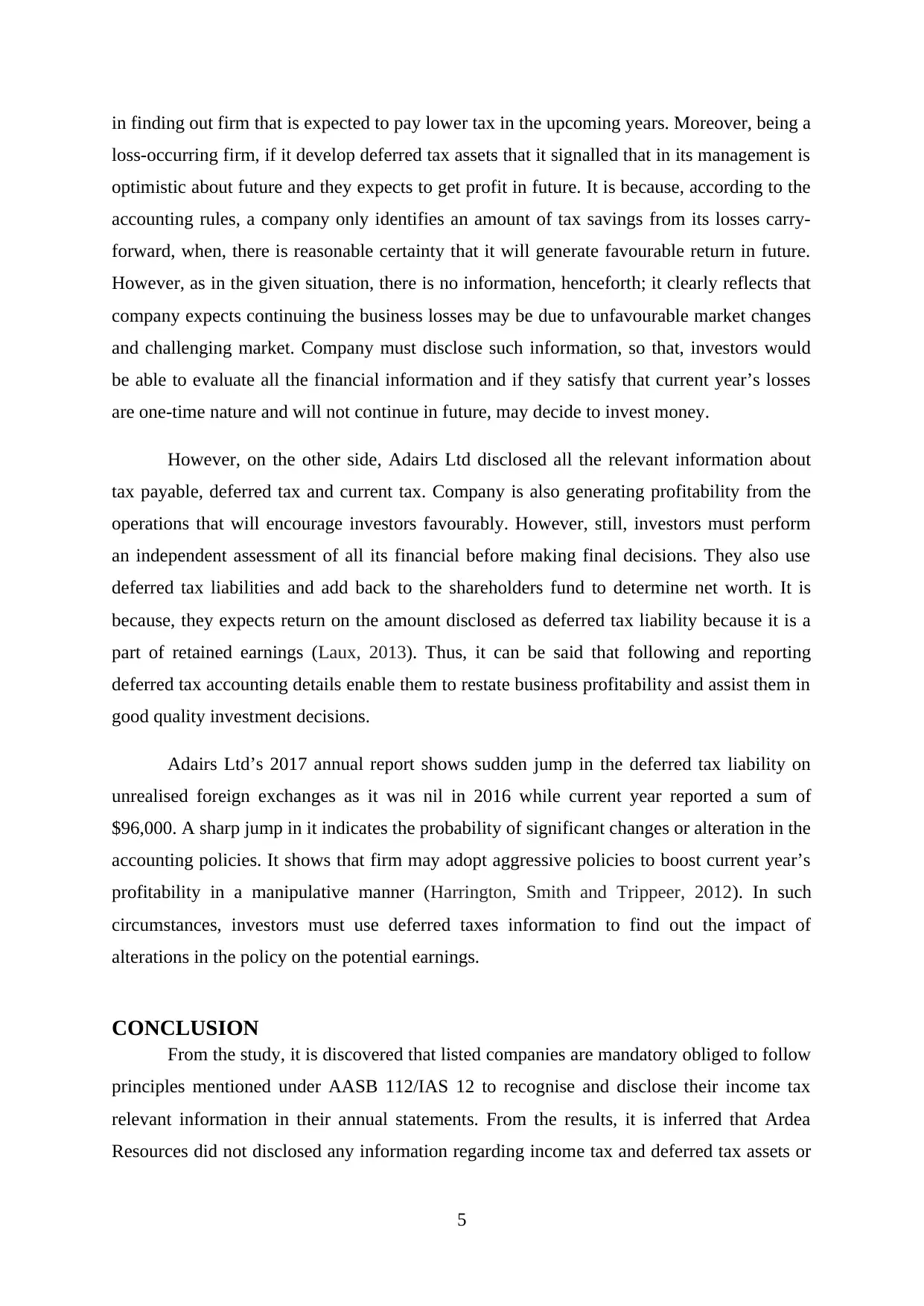
in finding out firm that is expected to pay lower tax in the upcoming years. Moreover, being a
loss-occurring firm, if it develop deferred tax assets that it signalled that in its management is
optimistic about future and they expects to get profit in future. It is because, according to the
accounting rules, a company only identifies an amount of tax savings from its losses carry-
forward, when, there is reasonable certainty that it will generate favourable return in future.
However, as in the given situation, there is no information, henceforth; it clearly reflects that
company expects continuing the business losses may be due to unfavourable market changes
and challenging market. Company must disclose such information, so that, investors would
be able to evaluate all the financial information and if they satisfy that current year’s losses
are one-time nature and will not continue in future, may decide to invest money.
However, on the other side, Adairs Ltd disclosed all the relevant information about
tax payable, deferred tax and current tax. Company is also generating profitability from the
operations that will encourage investors favourably. However, still, investors must perform
an independent assessment of all its financial before making final decisions. They also use
deferred tax liabilities and add back to the shareholders fund to determine net worth. It is
because, they expects return on the amount disclosed as deferred tax liability because it is a
part of retained earnings (Laux, 2013). Thus, it can be said that following and reporting
deferred tax accounting details enable them to restate business profitability and assist them in
good quality investment decisions.
Adairs Ltd’s 2017 annual report shows sudden jump in the deferred tax liability on
unrealised foreign exchanges as it was nil in 2016 while current year reported a sum of
$96,000. A sharp jump in it indicates the probability of significant changes or alteration in the
accounting policies. It shows that firm may adopt aggressive policies to boost current year’s
profitability in a manipulative manner (Harrington, Smith and Trippeer, 2012). In such
circumstances, investors must use deferred taxes information to find out the impact of
alterations in the policy on the potential earnings.
CONCLUSION
From the study, it is discovered that listed companies are mandatory obliged to follow
principles mentioned under AASB 112/IAS 12 to recognise and disclose their income tax
relevant information in their annual statements. From the results, it is inferred that Ardea
Resources did not disclosed any information regarding income tax and deferred tax assets or
5
loss-occurring firm, if it develop deferred tax assets that it signalled that in its management is
optimistic about future and they expects to get profit in future. It is because, according to the
accounting rules, a company only identifies an amount of tax savings from its losses carry-
forward, when, there is reasonable certainty that it will generate favourable return in future.
However, as in the given situation, there is no information, henceforth; it clearly reflects that
company expects continuing the business losses may be due to unfavourable market changes
and challenging market. Company must disclose such information, so that, investors would
be able to evaluate all the financial information and if they satisfy that current year’s losses
are one-time nature and will not continue in future, may decide to invest money.
However, on the other side, Adairs Ltd disclosed all the relevant information about
tax payable, deferred tax and current tax. Company is also generating profitability from the
operations that will encourage investors favourably. However, still, investors must perform
an independent assessment of all its financial before making final decisions. They also use
deferred tax liabilities and add back to the shareholders fund to determine net worth. It is
because, they expects return on the amount disclosed as deferred tax liability because it is a
part of retained earnings (Laux, 2013). Thus, it can be said that following and reporting
deferred tax accounting details enable them to restate business profitability and assist them in
good quality investment decisions.
Adairs Ltd’s 2017 annual report shows sudden jump in the deferred tax liability on
unrealised foreign exchanges as it was nil in 2016 while current year reported a sum of
$96,000. A sharp jump in it indicates the probability of significant changes or alteration in the
accounting policies. It shows that firm may adopt aggressive policies to boost current year’s
profitability in a manipulative manner (Harrington, Smith and Trippeer, 2012). In such
circumstances, investors must use deferred taxes information to find out the impact of
alterations in the policy on the potential earnings.
CONCLUSION
From the study, it is discovered that listed companies are mandatory obliged to follow
principles mentioned under AASB 112/IAS 12 to recognise and disclose their income tax
relevant information in their annual statements. From the results, it is inferred that Ardea
Resources did not disclosed any information regarding income tax and deferred tax assets or
5
Paraphrase This Document
Need a fresh take? Get an instant paraphrase of this document with our AI Paraphraser
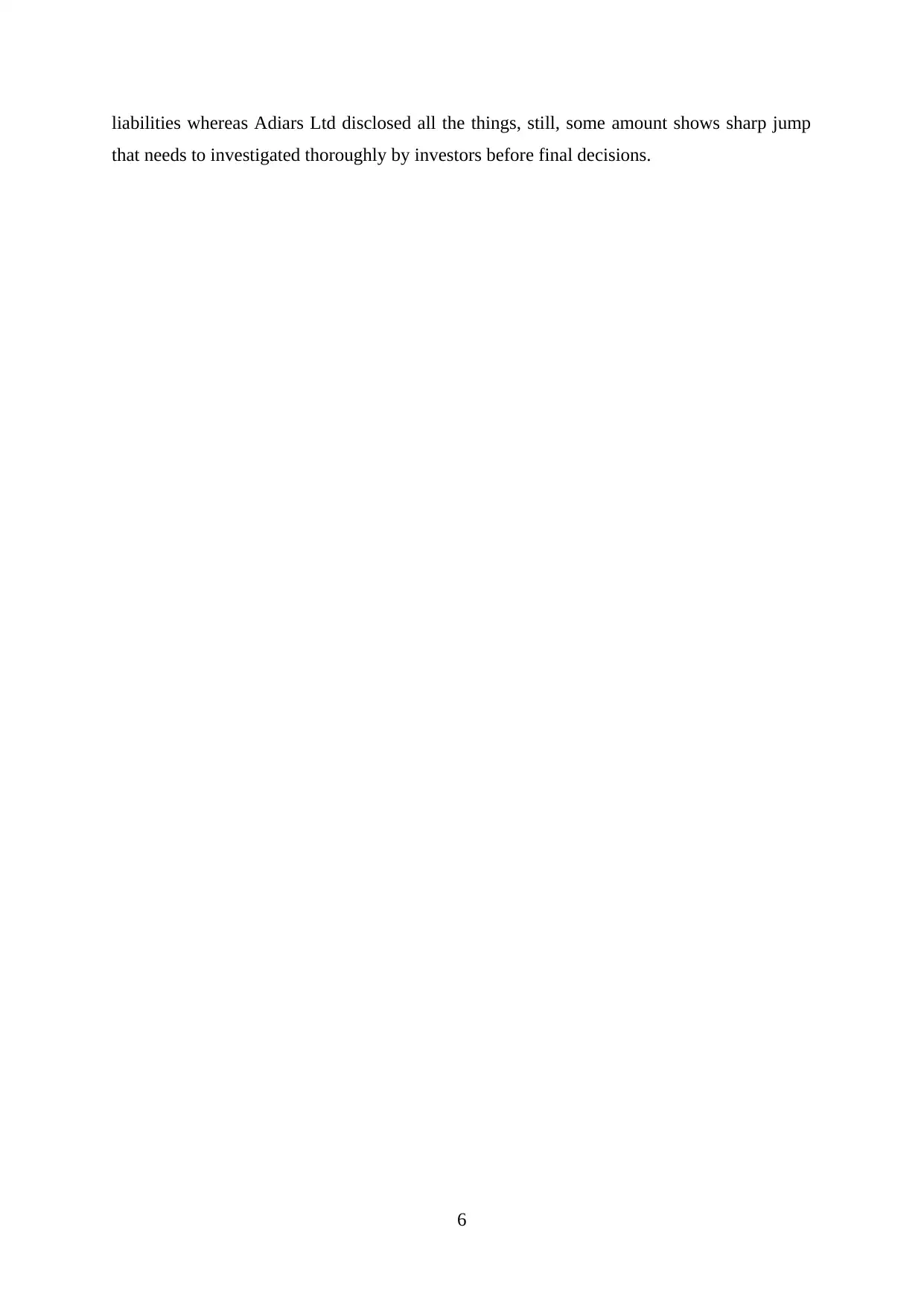
liabilities whereas Adiars Ltd disclosed all the things, still, some amount shows sharp jump
that needs to investigated thoroughly by investors before final decisions.
6
that needs to investigated thoroughly by investors before final decisions.
6
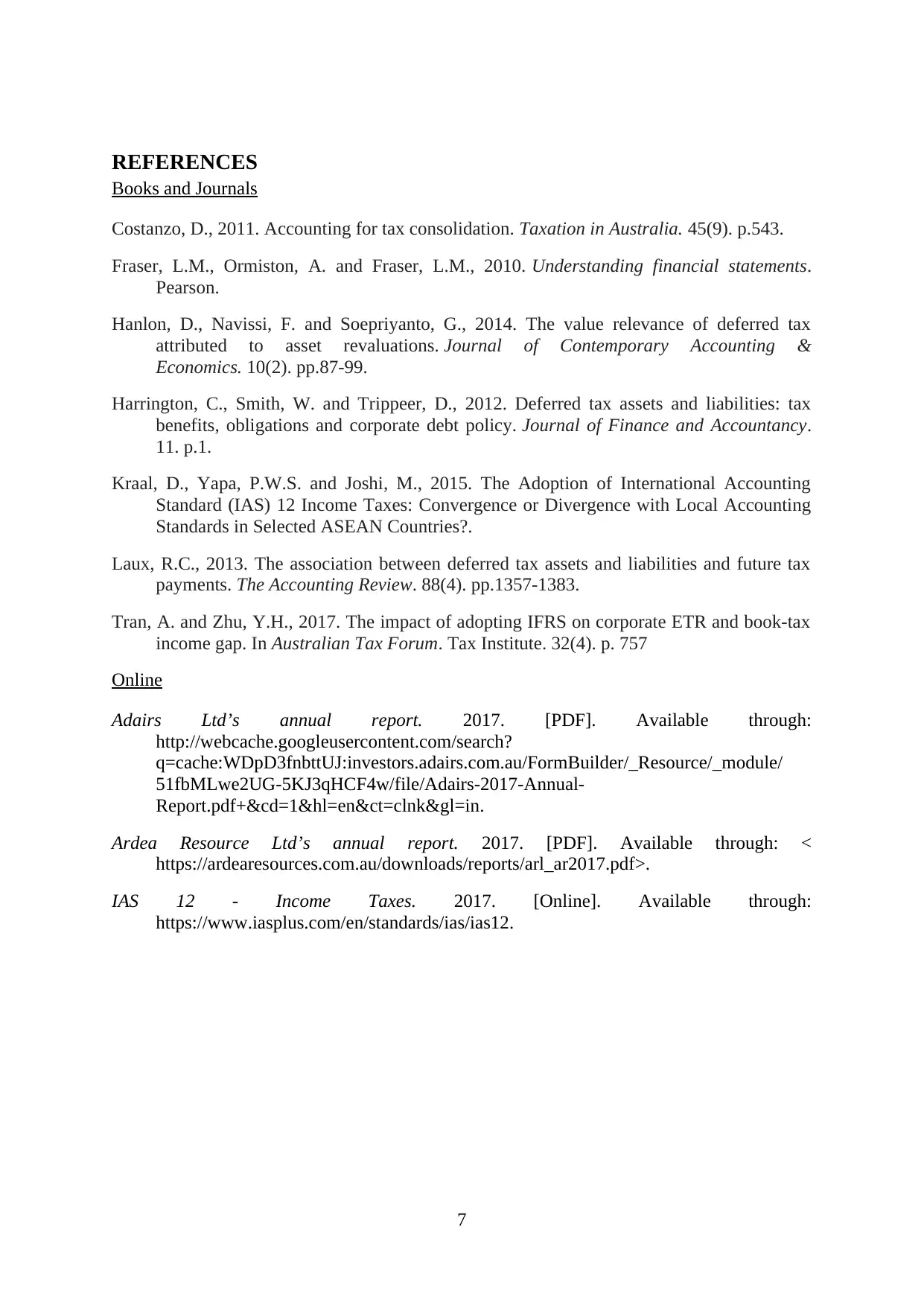
REFERENCES
Books and Journals
Costanzo, D., 2011. Accounting for tax consolidation. Taxation in Australia. 45(9). p.543.
Fraser, L.M., Ormiston, A. and Fraser, L.M., 2010. Understanding financial statements.
Pearson.
Hanlon, D., Navissi, F. and Soepriyanto, G., 2014. The value relevance of deferred tax
attributed to asset revaluations. Journal of Contemporary Accounting &
Economics. 10(2). pp.87-99.
Harrington, C., Smith, W. and Trippeer, D., 2012. Deferred tax assets and liabilities: tax
benefits, obligations and corporate debt policy. Journal of Finance and Accountancy.
11. p.1.
Kraal, D., Yapa, P.W.S. and Joshi, M., 2015. The Adoption of International Accounting
Standard (IAS) 12 Income Taxes: Convergence or Divergence with Local Accounting
Standards in Selected ASEAN Countries?.
Laux, R.C., 2013. The association between deferred tax assets and liabilities and future tax
payments. The Accounting Review. 88(4). pp.1357-1383.
Tran, A. and Zhu, Y.H., 2017. The impact of adopting IFRS on corporate ETR and book-tax
income gap. In Australian Tax Forum. Tax Institute. 32(4). p. 757
Online
Adairs Ltd’s annual report. 2017. [PDF]. Available through:
http://webcache.googleusercontent.com/search?
q=cache:WDpD3fnbttUJ:investors.adairs.com.au/FormBuilder/_Resource/_module/
51fbMLwe2UG-5KJ3qHCF4w/file/Adairs-2017-Annual-
Report.pdf+&cd=1&hl=en&ct=clnk&gl=in.
Ardea Resource Ltd’s annual report. 2017. [PDF]. Available through: <
https://ardearesources.com.au/downloads/reports/arl_ar2017.pdf>.
IAS 12 - Income Taxes. 2017. [Online]. Available through:
https://www.iasplus.com/en/standards/ias/ias12.
7
Books and Journals
Costanzo, D., 2011. Accounting for tax consolidation. Taxation in Australia. 45(9). p.543.
Fraser, L.M., Ormiston, A. and Fraser, L.M., 2010. Understanding financial statements.
Pearson.
Hanlon, D., Navissi, F. and Soepriyanto, G., 2014. The value relevance of deferred tax
attributed to asset revaluations. Journal of Contemporary Accounting &
Economics. 10(2). pp.87-99.
Harrington, C., Smith, W. and Trippeer, D., 2012. Deferred tax assets and liabilities: tax
benefits, obligations and corporate debt policy. Journal of Finance and Accountancy.
11. p.1.
Kraal, D., Yapa, P.W.S. and Joshi, M., 2015. The Adoption of International Accounting
Standard (IAS) 12 Income Taxes: Convergence or Divergence with Local Accounting
Standards in Selected ASEAN Countries?.
Laux, R.C., 2013. The association between deferred tax assets and liabilities and future tax
payments. The Accounting Review. 88(4). pp.1357-1383.
Tran, A. and Zhu, Y.H., 2017. The impact of adopting IFRS on corporate ETR and book-tax
income gap. In Australian Tax Forum. Tax Institute. 32(4). p. 757
Online
Adairs Ltd’s annual report. 2017. [PDF]. Available through:
http://webcache.googleusercontent.com/search?
q=cache:WDpD3fnbttUJ:investors.adairs.com.au/FormBuilder/_Resource/_module/
51fbMLwe2UG-5KJ3qHCF4w/file/Adairs-2017-Annual-
Report.pdf+&cd=1&hl=en&ct=clnk&gl=in.
Ardea Resource Ltd’s annual report. 2017. [PDF]. Available through: <
https://ardearesources.com.au/downloads/reports/arl_ar2017.pdf>.
IAS 12 - Income Taxes. 2017. [Online]. Available through:
https://www.iasplus.com/en/standards/ias/ias12.
7
⊘ This is a preview!⊘
Do you want full access?
Subscribe today to unlock all pages.

Trusted by 1+ million students worldwide

8
1 out of 10
Related Documents
Your All-in-One AI-Powered Toolkit for Academic Success.
+13062052269
info@desklib.com
Available 24*7 on WhatsApp / Email
![[object Object]](/_next/static/media/star-bottom.7253800d.svg)
Unlock your academic potential
Copyright © 2020–2025 A2Z Services. All Rights Reserved. Developed and managed by ZUCOL.





